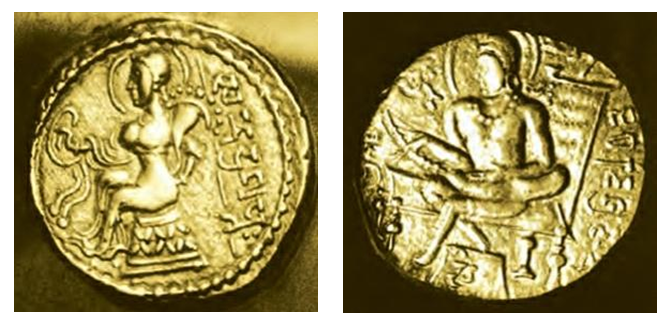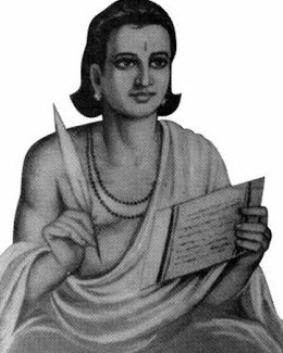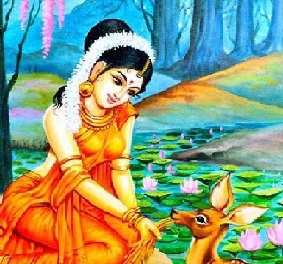Prashasti , Samudragupta's Prashasti, Genealogies, Harshvardhana & Harshcharita, Pallavas, Chalukyas, Pulakeshin
Prashasti , Samudragupta's Prashasti, Genealogies, Harshavardhana and Harshacharita
Samudra Gupta was one of the most important ruler of the Gupta Dynasty. The details on his life was inscribed on the Ashokan Pillar at Allahabad. It was composed as a Kavya by Harisena, a poet and a minister in the court of Samudra Gupta.
This inscription is called the Prashasti, which means in praise of. Prashasti was also composed for Gautamiputra Shri Satakarni.
In samudra Gupta's Prashasti, he is described as a great warrior who had won many victories in the battle. He was described as close to God. Some coins were issued on which he is portrayed as playing the Veena.

Harisena described about 4 important rulers and samudra Gupta’s equations with them.
- The rulers of Aryavarta and it’s nine rulers were uprooted. The whole of the kingdom was conquered by Samudra Gupta.
- The rulers of Dakshinapatha- it’s 12 rulers were defeated who then surrendered themselves to SamudraGupta. However, he then allowed them to rule again.
- The inner circle of neighbouring states like Assam, Coastal Bengal, Nepal, and other gana Sanghas paid tribute to him, followed his orders, and attended his court.
- The rulers of Kushanas and shakyas, Srilanka submitted themselves to him and offered their daughters for marriage.
Genealogies
Some Prashasti mentioned about SamudraGupta's Great Grandfather, grandfather, father, mother. His mother Kumara devi, belonged to the Lichchhavi gana, while his father, Chandragupta, was the first ruler of the Gupta dynasty to adopt the grand title of maharaj-adhiraja, This title was also enjoyed by Samudragupta. His great grandfather and grandfather were simply given the title of maha-rajas.
Vikram Samvat
The era beginning in the 58 BCE is traditionally associated with Gupta king, Chandragupta II. He had founded it as a mark of victory over the Shakyas and assumed the title of Vikramaditya.
Harshavardhana and Harshacharita
We came to know about Harshavardhana from his biography Harshacharita, which was composed by Banabhatta, his court poet. The biography was composed in Sanskrit. The biography explains the genealogy of Harsha which also includes his becoming the King. Xuan zang spend quality time at his court and gave a detailed account of his experience.
Although he was not the eldest son to his father, he ascended the throne after his father and elder brother died. His brother in law was the king of Kanauj, who was killed by the ruler of Bengal. Harsha then took over the kingdom of Kanauj and proceeded an army against Bengal.
He conquered Magadha and Bengal too, but when he proceeded to Deccan , he was stopped by the Chalukya Ruler, Pulakeshin II.
Pallavas, Chalukyas, Pulakeshin
The Pallavas and Chalukyas were the most important ruling dynasties in south India. The capital kingdom of the pallavas, Kanchipuram, to the Kaveri delta. Chalukyas’s kingdom was centred around the Raichur Doab, between the rivers Krishna and Tungabhadra.
Aihole, the capital of the Chalukyas, was an important trading centre. It developed as a religious centre, with a number of temples.
The best-known Chalukya ruler was Pulakeshin II. We Came to know about him from a prashasti, composed by his court poet Ravikirti. In the Prashasti, it was also mentioned that Pulakeshin also attacked the Pallava king, who took shelter behind the walls of Kanchipuram.
How were the kingdoms administered?
land revenue remained important for the rulers. The village remained the basic unit of administration. However, some other decisions for the development were also taken which are as follows:
- Administrative posts were hereditary. sons succeeded fathers. For example the poet Harishena was a maha-danda-nayaka, or chief judicial officer, like his father.
- One person held many offices. Like, Harishena was a kumar-amatya, means an important minister, and a sandhi-vigrahika, meaning a minister of war and peace.
- Besides, important men probably had a say in local administration. These included the nagarashreshthi or chief banker or merchant of the city, the sarthavaha or leader of the merchant caravans, the prathama-kulika or the chief craftsman, and the head of the kayasthas or scribes.
These policies turned out very effective. Sooner or later, some of these ministers became strong enough to set up their own independent kingdom.
Armies
Kings maintained a well-organised army, with elephants, chariots, cavalry and foot soldiers. There were military leaders also who provided the king with troops whenever he needed them. However they were not paid regular salaries but were given grants of land. They collected revenue from the land and used them to maintain soldiers and horses, and provide equipment for warfare. These men were known as samantas. Whenever the ruler was weak, samantas tried to become independent.
Assemblies
We find about local assemblies from the inscriptions by the pallavas. These included the sabha, which was an assembly of brahmin land owners. This assembly functioned through subcommittees. It looked after irrigation, agricultural operations, making roads, local temples, etc. The ur , was a village assembly found in areas where the land owners were not brahmins. And the nagaram was an organisation of merchants. These assemblies were controlled by rich and powerful landowners and merchants.
Lives of the ordinary people
We could know about the lives of ordinary people from the poems or the accounts left by the travellers or the visitors.

Kalidasa, a well known poet is known for his plays depicting life in the king’s court. According to his plays the king and most of the Brahmins are found speaking in Sanskrit, while the ordinary women and men speak Prakrit. His most famous play, Abhijnana Shakuntalam, is the story of the love between a king named Dushyanta and a young woman named Shakuntala. We find an
interesting description of the plight of a poor fisherman in this play.

The Chinese pilgrim Fa Xian noticed those who were treated as untouchables. They were expected to live on the outskirts of the city. He writes: “If such a man enters a town or a market place, he strikes a piece of wood, in order to keep himself separate; people, hearing this sound, know what it means and avoid touching him or brushing against him.”
The king’s Army
The king travelled with huge amount of equipment. There were other things of daily use such as pots, pans, furniture, golden footstools, food, including animals such as goat, deer, rabbits, vegetables, spices, carried on carts or loaded on to pack animals such as camels and elephants. This huge army was accompanied by musicians beating drums, and others playing horns and trumpets. Villagers accompanied them and brought gifts of curds, gur and flowers, and provided fodder for the animals. They also tried to meet the king, and place their complaints and petitions before him.

 Indira Gandhi Memorial High School
Indira Gandhi Memorial High School
